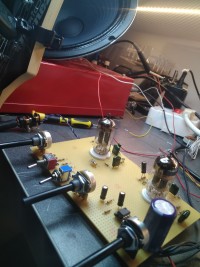Guitar amplifier

Build an affordable and good sounding guitar amplifier.
Most high-quality guitar amplifiers inevitably work with tubes: Widely praised for the pleasant-sounding distortion and warm sounds. In addition, I notice that many high-quality guitar amplifiers only really come into their own when the volume knob is turned wide open. The power is usually between 50W and 100W which causes serious sound volumes to be needed to get a greasy tube sound.
My idea is to build a small combo amplifier with limited audio power, just with the intention of getting a good tube sound at a lower volume.
The combo consists of 2 channels: a clean/crunch channel and a distortion channel. The channels are switched to a send/return switch with a toggle switch to be able to add additional effects after the preamplifier. After that, everything goes through a 3-band equalizer. The power amplifier is a module of KEMO. Reliable, good sounding and not expensive. ) For the master volume button I added a "soft-clip limiter" circuit with diodes to get enough sound volume with limited audio power, without transferring the output stage.
The idea is also to run the tubes of the preamplifier on an easily manageable 48V power supply. This is a lot easier and cheaper to realize than the 2 to 300V DC that is normally used. I started experimenting with this idea and to my great surprise a standard 12AX7 tube is perfectly adjustable with a lower supply voltage, without compromising on sound quality.
The guitar signal is connected to a mono jack connection and ends up on U2A via R1. This tube amplifies the signal 27dB (20 log (24), the working point is 23V DC, no clipping occurs.
The used loudspeaker is a Celestion Ten30. This is an affordable speaker that sounds great. It is a 8-ohm speaker. For more power you can put two in parallel as a 4-ohm load.
For more details please see the attached documents and the project updates below.
My idea is to build a small combo amplifier with limited audio power, just with the intention of getting a good tube sound at a lower volume.
The combo consists of 2 channels: a clean/crunch channel and a distortion channel. The channels are switched to a send/return switch with a toggle switch to be able to add additional effects after the preamplifier. After that, everything goes through a 3-band equalizer. The power amplifier is a module of KEMO. Reliable, good sounding and not expensive. ) For the master volume button I added a "soft-clip limiter" circuit with diodes to get enough sound volume with limited audio power, without transferring the output stage.
The idea is also to run the tubes of the preamplifier on an easily manageable 48V power supply. This is a lot easier and cheaper to realize than the 2 to 300V DC that is normally used. I started experimenting with this idea and to my great surprise a standard 12AX7 tube is perfectly adjustable with a lower supply voltage, without compromising on sound quality.
The guitar signal is connected to a mono jack connection and ends up on U2A via R1. This tube amplifies the signal 27dB (20 log (24), the working point is 23V DC, no clipping occurs.
The used loudspeaker is a Celestion Ten30. This is an affordable speaker that sounds great. It is a 8-ohm speaker. For more power you can put two in parallel as a 4-ohm load.
For more details please see the attached documents and the project updates below.






Updates van de auteur
frederik 3 jaar geleden
dimigav 3 jaar geleden
The transformers are toroidal?
The potentiometers are linear or log?
The non polarized capacitors are ceramic or polyester and the polarized capacitors electrolytic or tantalium?
Zener and resistor wattage?
Speaker cabin dimensions?
Thanks!!!
Very good project..
frederik 3 jaar geleden
The transformers are toroidal? 2x 12V yes, the 48V no
The potentiometers are linear or log? all are log exept tone controls: these are linear
The non polarized capacitors are ceramic or polyester and the polarized capacitors electrolytic or tantalium?
NP= polyester, POL= electrolytic
Have fun with it, it sounds fantastic to me :-)
dimigav 3 jaar geleden
About Zener wattage.
Resistor wattage is 1/4W except R32, R33, R34?
and speaker cabin dimension (this is critical for sound quality)..
Thanks for your reply!!!
I will try to test it with electroacoustic guitar..
ps.
The tubes are lit or not? Maybe if they are visible out of the case is better idea?
frederik 3 jaar geleden
Zener wattage is 0.5W
Resistors indeed 1/4W except R32, 33 and 34
Tubes run on 12V heaters, they run hot but no need to put them outside the cabin.
dimigav 3 jaar geleden
Can you provide some part numbers for the audio receptacles (J2, J3, J4, J5 and J6)?
frederik 3 jaar geleden
Most high-quality guitar amplifiers inevitably work with tubes: Widely praised for the pleasant-sounding distortion and warm sounds.
In addition, I notice that many high-quality guitaramplifiers only really come into their own when the volume knob is turned wide open. The power is usually between 50W and 100W which causes serious sound volumes to be needed to get a greasy tube sound.
My idea is to build a small combo amplifier with limited audio power, just with the intention of getting a good tube sound at a lower volume.
The combo consists of 2 channels: a clean/crunch channel and a distortion channel. The channels are switched with a toggle switch to a send/return schematic to be able to add additional effects after the preamplifier. After that, everything goes through a 3-band equaliser. The power amplifier is a module of KEMO. Reliable, good sounding and not expensive. For the master volumebutton I added a "softclip limiter" circuit with diodes to get enough sound volume with limited audio power, without overdriving the output stage.
The idea is also to run the tubes of the preamplifier on an easily manageable 48V power supply. This is a lot easier and cheaper to realize than the 200 to 300V DC that is normally used. I started experimenting with this idea and to my great surprise a standard 12AX7 tube is perfectly adjustable with a lower supply voltage, without compromising on sound quality.
See tube amp V11.pdf
The guitar signal is connected to a mono jack connection and ends up on U2A via R1. This tube amplifies the signal 27dB (20 log (24),the workingpoint is23V DC, no clipping occurs.
CLEAN/CRUNCH CHANNEL
The crunch effect is obtained by deforming the signal asymmetrically. U2B is set so that the DC workpoint is around 30V. As a result, only the top of the sine clips.
See crunch.bmp
With SW1 you can switch between clean and crunch,by simply reducing the signal or not.
See clean.bmp
With the "bright" switch SW2, some low tones can be filtered out via C5.
C11 gives an additional reduction of the bass .
DISTORTION CHANNEL
The distortion channel is realized with U1A and U1B. The signal is symmetrically distorted with 2 amplifier stages, and heavily clipped. Both stages are identically DC biased, U1B provides more amplification by adding C15.
See distortion.bmp
Via voltage dividers R9/R11 and R18/R19, both the clean/crunch and the distortion signals are reduced to line level. Switch SW4 ensures the choice between the 2 channels. Note that the distortion channel is switched to ground when choosing the clean/crunch channel. (SW4B) This is to avoid affecting the clean signal from the U1B grid .
The send/return schematic is quite simple: 2 TL072 opamps (U3) both buffer the input and output signal. 2 jack sockets are mechanically varied to add additional effects in the barrel.
Then the return signal ends up on a 3 band equaliser. Unlike most guitaramplifiers, this one is not equipped with a classic "cowtail". A more effective circuit with an opamp (U7A) and 3 independent controls ensures a tonecontrol of +/- 10dB for low (<100Hz) mid (1kHz) and treble (>10kHz).
Because the amplifier is quite limited in power and volume, there is a high risk that, incase of solid guitarstops, the power stage will be clipped. To avoid this, I added a simple diode limiter. When the signal comes close to 2Vpp, then the 6 diodes (D5... D10) start to conduct more and more and soft clip the signal. This ensures that hard clipping distortion never occurs when the volume is rotated "at 11".
See limiter.bmp
Capacitor C34 (10n) limits the bandwidth of the amplifier to about 15kHz. Note that no bandwidth restriction has ever been applied before!
The signal is then sent via R29 and P6 to the KEMO amplifier module. (see https://www.kemo-electronic.de/en/Light-Sound/Amplifier-Splitter/Modules/M032N-Amplifier-12-W-universal.php) This module is robust and easy to connect. The sensitivity of the input is quite high; 120mVpp for full control! Met Relais K1 is made into a switch-on delay. When the supply voltage is set up, capacitor C35 charges slowly via R30. After a few seconds, the voltage over C35 is > 5.6V+0.7V (BE transition from Q1) and Q1 starts conducting, causing the relay to switch on.
SW5 is intended as a "power reduction" to have an option for even lower power on the speaker, by adding R31 in series with the speaker.
There is also a headphones out via R33 and C37.
The power supply of the amplifier is quite straightforward, 2 transformers are used via SW1 and F1. The +/-12V is obtained with 2 classic voltage regulators.
The 48V power supply is also made with a 7812 regulator. To get 48V I use a 36V zenerdiode in the GND circuit of the controller. This adds 36V to the stabilized 12V of the 7812, which brings it to 48V. R17 provides a bias flow through the zener. D3 ensures that the output, when switching the amplifier on or off, can never exceed the input voltage. This is something that voltage regulators are very sensitive to!
The speaker I use is a 10 inch 30W Celestion Ten-30. This speaker combines warm lows with a vocal mid-range and an articulate top end. The clean sound is open and revealing; push hard and you’re rewarded with full-blooded Celestion grind.
clean-20210411224330.bmp (293kb)
crunch.bmp (293kb)
limiter.bmp (293kb)
distortion.bmp (293kb)
tube amp V11.zip (143kb)
frederik 4 jaar geleden
frederik 4 jaar geleden
I removed R9 and R14 and changed R15 to 470K.
This way i push the distortion a little more!
Because the level way too high compared to the clean chanel, i lowered R21 to 12K.
frederik 4 jaar geleden
- add power switch and fuse
- add heaphones out
img-20210314-102329.jpg (1085kb)
img-20210314-102240.jpg (877kb)
img-20210314-164131.jpg (1703kb)
img-20210314-102248.jpg (997kb)
img-20210314-102259.jpg (912kb)
img-20210314-102329.jpg (1085kb)
img-20210314-164131.jpg (1703kb)
frederik 4 jaar geleden
There is less volume difference between clean and distortion, everything seems more balanced now.
thumbnail-img-20210228-160950.jpg (277kb)
frederik 4 jaar geleden
- I removed C1
- I played around with the DC working point of the tubes and changed R17, R6, R11. I now get better sound shaping.
- I changed C11 to 1nF: better "bright effect"
- I add double switch to eleminate the influence of the distortion channel on the clean channel when clean is selected.
I like the sound of this amplifier. At reasonable low volumes it has a good sound on both clean, crunch and distortion channels. I will do some testing with the effects loop (im waiting for a Behringer HD300 pedal)
frederik 4 jaar geleden
I now have a good sounding guitar amplifier with 3 basic tone shapes:
Clean:
U1A and U1B with SW1 ON. U1A now is now set to maximum gain (C3) This way the signal is slightly deformed and gets a richer sound. See clean.bmp
Crunch:
U1B is DC biased around 38V, so the signal gets distorted in an assymetrical way. This way, we get a crunch type sound. See crunch.bmp
I have add a "bright" switch to filter out some of the low end if needed.
Distortion:
U2A and U2B overdrive the signal so we get a "metal" sound. See distortion.bmp
I removed the diodes. Now ithis chanel really sounds agressive and harsh :-)
I have add a mid tone controle, so now we have a low, mid and high section, all running around 1kHz.
I use a Kemo integrated 12W amp module. The input of this amp is very sensitive. Max 60mV is alowed!
Because the dynamic range of a guitar is very high, its very easy to overdrive the end stage.
I found a solution to avoid hard clipping of the power amp by using 2x 3 diodes. As soon as the signal gets beyond 2V, the diodes start to conduct and gently compress the signal. This way we get a smooth clipping, what avoids hard clipping distortion.
In normal conditions, the diodes never conduct, so a clean or tube distorted sound is always possible. Only when we abuse the amp, sounds levels are limited trough the diodes. This works very well.
I have also add a delayed speaker switch to avoid plops when the amp is switched on.
crunch.bmp (293kb)
distortion.bmp (293kb)
input.bmp (293kb)
tube amp V5.pdf (130kb)
frederik 4 jaar geleden
BAD IDEA....
I use a 12V and 48V Mean Well powersupply .... they produce a massive amount of noise and hum.
Due to the high impedance design of the pre amps, this is not usable! Lesson learned.
My second bad idea was to use a small class D amplifier. Energy efficient and a lot of value for the money. See https://www.adafruit.com/product/1752
Again, a lot of noise and switching products picked up by the pre amp .....
I will go for the classic transformer/rectifier/elco design for my power supply.
And a basic class AB amp module.
More to come soon!
frederik 4 jaar geleden
I use a separate 12V supply to heat the tubes and run the buffer opamp (not on my schematic now)
See PreampV1.pdf
V1 is the input triode amp. Input impedance is set to 1M
The gain of this tube is set with R2, avoid clipping here!
V2 is a second amplifier tube, which forms the "normal" channel
S1 reduces the signal by half, so we have a clean sound on the output. (see normal-clean.jpg)
With S2 "open, we overdrive V2 a little to have a "crunch sound" (see normal-crunch.jpg)
With V3 and V4 I make the distortion channel.
D1 and D2 add a little extra hard clipping, what gives a nice sound! (see distortion.jpg)
With the lower supply voltage, we can not set the tubes in high gain, but to me the sound is very warm, the distortion sounds really good.
I now use a regular hifi amp to test (never let it clip!) and my speaker is a Celestion Ten30. (affordable and good sounding for guitar)
I plan to make some tone controls and i will experiment with 2 x TDA2003 amps in bridge mode to have about 10W power with a 12V supply
normal-clean.jpg (959kb)
normal-crunch.jpg (857kb)